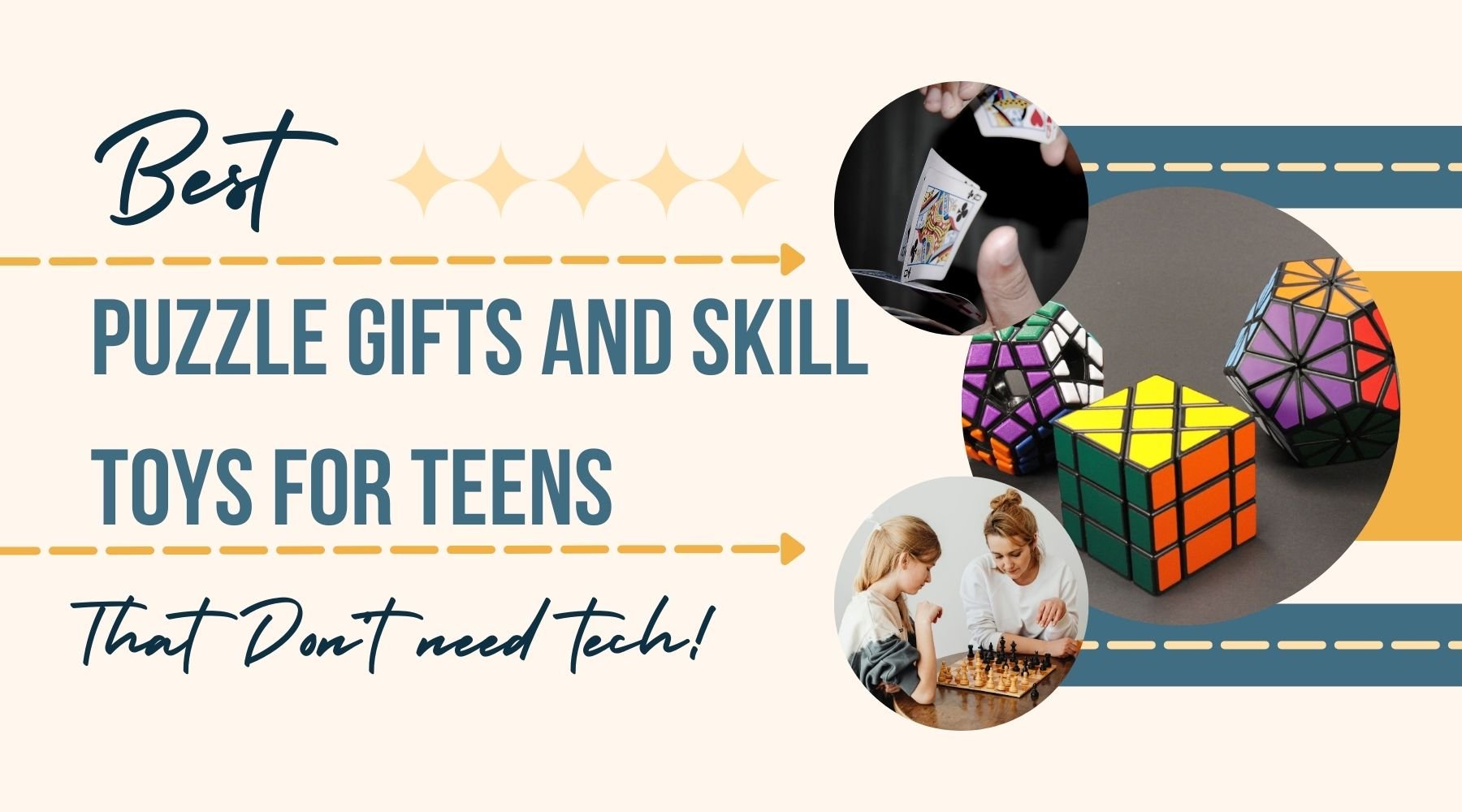Gifts are always tricky to buy. Ask a kid what they’d like as a gift, they’ll almost always pick something unhealthy. In these times when teens are drowning in a sea of technology, being bombarded with notifications and never-ending scrolling on smartphones, the best gift you can give them is anything to disconnect. Taking away their smartphones is now a form of punishment. To get teens and tweens to want to unplug, what’s needed is an alternative pastime that doesn’t require an internet connection. Better yet, activities that require no power, other than brain power.
7 of the Best No-Tech Puzzle Gifts Every Teen Should Try
1. Q and A Riddles

Brain teasers are just the thing for long trips to keep the kids amused. Forget the tablets and Netflix streams. Ditch the tech, save your Wi-Fi and swap a game of I-Spy for some brain teaser fun like riddles, which are essentially trick questions that make people think.
Answer. A coin.
Answer. A cold.
Answer. An egg.
2. Combination Puzzles

By Gerwin Sturm from Vienna, Austria via Wikimedia Commons | CC BY-SA 2.0
For those who are lost when their fingers aren’t tapping screens, keep their hands occupied with a combination puzzle. The simplest, according to the creator of Jaapsch.net, Jaap Scherphuis, is the Pyraminx, yet even that has a total of 933,120 possible combinations. A skewb is more difficult with a possible 3.1 million combos. The next difficult is a 2x2 Rubik’s cube with 3.6 million possible combinations and the ultra-difficult is the traditional 3x3 Rubik’s puzzle with a possible 43+ million moves.
3. Jigsaw Puzzles

For teens more likely to be feeling pressure from studies, and peers, possibly feeling like life’s throwing every hurdle imaginable at them, jigsaws are the ultimate switch-off because it uses the left and right side of the brain.
If 2D puzzles don’t hold their attention, consider 3D puzzles. Brands like Ravensburger have a range of models to suit different interests, such as buses and cars for fans of vehicles, or 3D globe puzzles for those fascinated with cultures around the world.
4. DIY Puzzle Kits

DIY puzzle kits take jigsawing to another level. Kits contain all the materials needed to assemble the puzzle. Some may not include glue, paints, or stickers, but instead, only the essentials to construct the puzzle. Once the kit is assembled, it can be glued together to keep it intact, or taken apart to redo again, and again. There are different types too. Choose from metal model kits, mechanical kits, wood puzzles, or something with more decor appeal. For something with a lot more ways to customize the kit, premium DIY book nook kits are available in puzzle form. Once complete, they’re the perfect size to slot between books on a bookshelf creating the illusion of a miniature world.
5. Word and Number Games

By Nemo's Great Uncle | CC BY-NC-SA 2.0
Word and number games appeal to different people. Fans of literature who like to test their knowledge are more likely to enjoy word puzzles. There’s various types so things can be mixed up to keep the puzzles interesting. Choose from traditional crosswords, cryptic crosswords, anagrams, hidden answers, and classic word search puzzles.
Numbers-based games have more of an appeal to logical thinkers. In this category, the most popular game is sudoku. Others include KenKen which involves more mathematical problem solving, and Hidato. For those not too keen on paper-based puzzles, preferring something more hands-on, there’s Scrabble (available in different languages, which can help with learning too), and less competitive logic games like Bananagrams.
6. Board and Card Games

Board games cover the gamut of age ranges and each can let everyone disconnect from life for the duration of the gameplay. That’s the joy of playing together. To forget life’s woes and be present in the present as a group of friends or as a family unit. They also span various genres so there’s bound to something for everyone.
Strategic thinkers are likely to enjoy games like Chess and Catan. For larger groups, party games include Pictionary and Charades. For those with a flair for drama and storytelling, role-playing board games like Dungeons and Dragons and HeroQuest may be more enjoyable.
Card games can range from hundreds of possible games from a single standard deck of cards to more unique games such as Uno, Exploding Kittens, and Love Letter.
7. Skill Toys
Skill toys engage in the same way puzzles do but are far more interactive. These are terrific for holding attention because they require focus, concentration and plenty of practice. Some examples of skill-based games include:
- Fingerboarding

This is a miniaturized version of skateboarding. Miniature skateboards are made of wood or plastic and miniature skate parks can be set up with ramps, rails, and ledges. The objective is to perform skateboarding tricks using only your fingers.
- Kendama

Kendama is a Japanese skill toy. It has a handle, three sets of cups in different sizes, and a ball attached to it with a piece of string. The objective of the game is to toss the ball from the handle and catch it in one of the cups. There can be as many as 30,000 moves and one of the main draws of it is the sheer number of Kendama tricks that can be done.
- Yoyoing

Yoyos are the most basic of toys, yet it can take a ton of practice to master. Yoyo tricks number in the thousands and can be categorized as easy (beginner) to advanced tricks that can take years to perfect.
- Cardistry

Cardistry is mastering the movements of a deck of cards. It involves manipulating the cards to create aesthetic illusions like fans, and aerial movements - flicking a card or a deck of cards in the air and catching them single-handedly.
By Hash Milhan| CC BY 2.0




Share:
9 Bookshelf Accessories Every Globetrotter Needs
How to Start a Book Club that People Attend In-Person